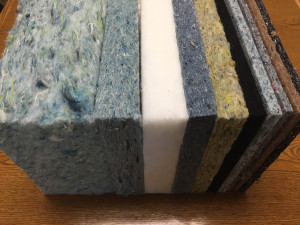
A vibrant North American market for industrial and protective textiles is evident at Techtextil/Texprocess.
Techtextil/Texprocess N.A., which finished its three-day run May 5, brought North American performance and protective apparel and industrial product manufacturers together with some 519 exhibitors of the latest textile materials and manufacturing processes. The Messe Frankfurt GmbH show took place in Atlanta in conjunction with the JEC Americas Composites show.
Exhibitors from Europe and Asia confirmed the importance of the North American technical markets—and there is an increase in foreign manufacturers setting up textile operations in the U.S. Dave Gardner, managing director of the Sewn Products Equipment & Suppliers of America (SPESA), which co-sponsored the Texprocess show, told the press, “Our industry is really coming back home, and China and India are seeing the advantages of manufacturing in the U.S.A.”
PPE is driving innovation
With 40 percent of the total volume share, North America has become the leading consumer of technical textiles for personal protective equipment (PPE), according to Mary-Lynn Landgraf, senior international trade specialist for the U.S. Dept. of Commerce/OTEXA.
Rich Lippert, marketing director at Glen Raven Technical Fabrics (GRTF), concurred. “In general, we are seeing an increased demand for the traceability and peace-of-mind afforded by U.S.-sourced FR materials.” Lippert also commented that GRTF was seeing growth in the geosynthetics market, particularly in India and China.
Innovations introduced
A number of companies showcased new products with advanced performance capabilities. GRTF’s latest introduction to its GlenGuard FR line is its HI-VIS fabrics, with or without anti-stat, in their patented no melt/no drip modacrylic blend.
Mount Vernon FR, the protective fabrics division of Mount Vernon Mills, have added MY•FR custom yarn-dyed patterns to their AMTEX® PLUS line of 88 percent cotton/12 percent nylon fabrics; along with a range of quilted FR fabrics, called Nanuq CWI, for cold weather protection against electric arc flash and flash fires.
SSM Industries Inc. featured a new line of flame-resistant filament fabrics called Pro-FilFR®. The no melt/no drip fabrics offer brilliant colors (including hi-visibility colors), high wicking capability and UV resistance, and are intended for next-to-skin garments, fire gear liners, clean room garments, mattress ticking, and other end uses requiring arc/FR protection.
Germany’s Olbo & Mehler introduced a customized 100 percent basalt fabric for high-temperature applications up to 1,350˚F in industrial and construction end uses. The fabric is also said to have unique resistance against chemicals. The company is looking to invest in the U.S. market to increase share in specific industrial markets.
Norofin, a German nonwovens manufacturer, recently introduced its Komanda® line of custom-engineered protective materials for arc flash protection. Manufactured from inherently FR materials, Komanda® textiles are extremely lightweight, washable, and abrasion resistant.
Nonwovens encompassing “our whole lives”
From protective materials to insulation, wipes, filter media, and a host of other applications, nonwovens are also a growing segment of the North American textile industry, with sustainable materials increasingly involved.
Sandler AG, also from Germany, presented a diverse range of nonwovens, including wipes for hygiene and cleaning with a focus on recyclable and skin-friendly synthetics. The company is in the process of setting up a plant in Houston County, Ga., as “an active point of entry into the North American market,” it says.
The Poole Company’s EcoSure® BioBlast™ biodegradable polyester fibers, currently used in household wipes, are designed to break down in 12–24 months in landfill environments. The fibers are manufactured from 100 percent recycled PET bottles and are said to have the same physical properties as traditional polyester.
Carolina Nonwovens LLC, a division of National Spinning Company Inc., has invested $15 million in a new facility for the manufacture of thermal and acoustic insulations, automotive liners and mattress components. Some 85 percent of these industrial nonwovens are made with recycled or regenerated fibers and offer an alternative to less sustainable foam materials.
Tip of the innovation iceberg
A number of Techtextil exhibitors were focusing on the development of new materials for the composites industry, such as Gehring Textiles’ Trafusion™ Runner, an alternative to the spiral wrap tubing used to distribute resin or provide vacuum distribution in the vacuum infusion process for composites.
The growing synergy between industrial textiles and composites is sure to inspire exciting innovations in future materials.
Debra Cobb is a freelance writer with extensive experience in the textiles industry.
 TEXTILES.ORG
TEXTILES.ORG


